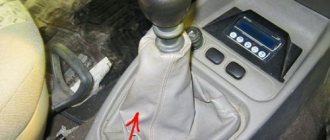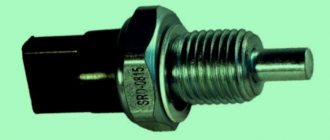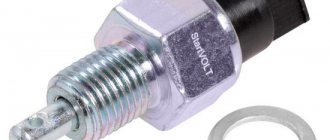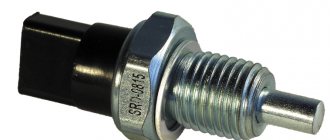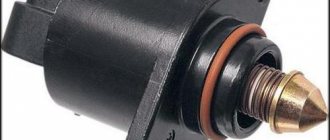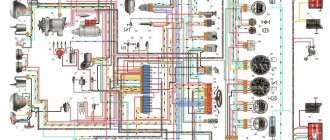To complete the work you will need:
— inspection ditch or overpass;
1. We prepare the car for work.
2. Remove the engine splash guard or engine crankcase protection (if installed).
3. Disconnect the wire block from the solenoid.
4. Using a voltmeter, check the voltage at terminal 1 of the block (to which the red wire goes). When the ignition is on, there should be a voltage of about 12V at the terminal. If there is no voltage or it is less than 10 V, check fuse F21 of the solenoid circuit.
5. Using an ohmmeter, we measure the electrical resistance of the solenoid coil, which should be about 13 ohms.
6. If the solenoid resistance is normal, apply 12 V voltage from the battery to its terminals. A characteristic click should be heard. We replace the faulty solenoid.
If the check does not reveal a malfunction and the lock does not turn off, you should check the reverse lock transmission switch. If the switch is working properly, you should unscrew the solenoid from the box (see below) and make sure that when 12 V is applied to its terminals, the solenoid core is fully retracted.
If the reverse gear lock stops turning off while on the road, you can unscrew the solenoid by 8-10 mm. Wrap electrical tape tightly around the visible threads of the solenoid. While squeezing this tape, turn the solenoid a few turns so that there is a distance of 6-7mm between the solenoid flange and the gearbox housing. When getting to the parking or repair site, be careful - when engaging first gear, reverse gear may be engaged by mistake.
1. Drain the oil from the gearbox.
2. 36 mm spanner to loosen the solenoid.
3. 13 mm spanner to unscrew the reverse gear fork lock plug (it prevents the solenoid from being unscrewed).
4. We take out the clamp spring.
5. To avoid losing it, use a magnetic pointer to remove the locking ball.
6. Using sliding pliers and a 36 mm , loosen the tightening of the solenoid.
7. We unscrew the gearbox housing solenoid.
We install the new solenoid in the reverse order, after first applying sealant to its threaded part and removing oil leaks from the gearbox housing.
Source
Causes of reverse gear failure on Lada Kalina and ways to fix the problem
Technological progress does not stand still. More advanced technologies are being introduced into literally all areas of life. This also applies to cars: both foreign-made and domestic. However, updates are not always beneficial. For example, the electronics installed in the Lada Kalina do not so much make it easier as they complicate the life of the owner. The most common malfunction in this car, caused by the operation of electronic systems, is a refusal to engage reverse gear. The reasons and solutions to this problem will be discussed further.
Let's sum it up
The reverse sensor is very important for the functioning of the Lada Kalina reverse gear system. Periodic inspection of the condition of the supply wiring, as well as the element itself, will allow the owner to prevent a malfunction in advance and minimize the risk of an unpleasant situation on the road.
For stable engine idle operation, the Kalina idle speed sensor is designed. In this article we will talk about the Lada Kalina - about the characteristic features of the device on this car, what problems may arise and how to fix them, and recommendations for replacing the device will also be given.
Reverse sensor
What is a reverse gear locking mechanism?
To move the car back in Kalina, a whole scheme is provided. The gearbox in the car is equipped with a special solenoid that helps engage reverse. However, the reverse connection mechanism has a somewhat unusual algorithm, introduced by AvtoVAZ engineers for the purpose of being on the safe side. First, the driver moves the gearshift lever toward himself and forward, gripping a special plastic ring. But what happens inside at this moment: the ring allows the magnetic switch to be activated, after which the solenoid moves to the ground of the car. This, in turn, allows the solenoid auger to move in the rearward direction.
Reading the instruction manual
The instructions included with Kalina-2 hatchbacks and station wagons say the following:
According to reviews, 3 seconds will be enough. By the way, the blocking stops working not after 3 seconds, but earlier. But if you switch immediately, there is a risk of breaking the gear teeth. All this, of course, is true only for the break-in period.
As the owners themselves say, reverse gear is engaged perfectly even on a car with “zero” mileage. But the driver is required to show dexterity: having squeezed the clutch to the maximum, the pedal is then moved back a little. The handle moves to the desired position and the pedal is fully released.
Clutch pedal response zones
You can also turn it on “through neutral”. This method is the most reliable. Release the pedal when the handle is in neutral and you are guaranteed to be able to shift into any gear. Actually, the method is suitable for any car and any manual transmission. But regarding AvtoVAZ products, the advice sounds like this: take a 3-second pause.
Why the Lada Kalina stopped turning on: reasons and solutions
Failure of the locking mechanism fuse
Since this device in the Lada Kalina is of electronic origin, it is first of all worth examining the electronic systems. To do this, you need to check the condition of the corresponding relay and fuse, which are located in the mounting block. Its cover is located under the handle for turning on the dimensions. Open it and evaluate the functionality of the fuse responsible for the operation of the transmission reverse lock circuit.
The documentary designation of the required element is F21. The current rating of this component is 10A. The location can be seen in the photo below.
F21 (10) - the fuse you need
To determine the true cause, remove the fuse from its socket and carefully analyze the condition of the jumpers. If the part is damaged, the integrity of the jumper will be compromised.
Option to solve the problem: replacing the fuse with a new one is the only way.
Important! If a newly installed mechanism quickly fails, then the cause must be sought in the solenoid.
Magnetic switch failure
As a rule, such breakdowns are not so common due to the fact that the magnet itself is a fairly durable spare part and has a sufficient working life. However, if the reverse gear fails, it would not be superfluous to check it too.
The procedure is as follows:
- Remove the cover from the manual transmission lever.
Stage 1: removing the protective casing - Locate the connector that connects the lever and separate it.
- To check the operation of the reverse gear in stand-alone mode, close the contacts using a wire.
Where do you need to close the contacts? - Engage reverse gear.
But here there are possible options. If the reverse gear engages freely after completing all the manipulations, then the reason is in the magnetic switch. However, before disassembling the box and removing the magnet, it is worth analyzing the operation of the plastic ring: it should rise easily and without distortion until it clicks. Due to its wear, the ring may not move the required distance, and this may also result in reverse gear failure.
A solution to the problem: replacing the reed switch (magnet) or ring with new ones.
There is no voltage supplied by the solenoid to the manual transmission lever
This is most often the cause of malfunction of the reverse gear locking mechanism on Kalina. And here we must thank the AvtoVAZ engineers, who placed the wire supplying power from the solenoid to the lever in an unusually bad place - under the bottom of the car. He has to endure a lot: the action of reagents that are generously sprinkled on roads in winter, and water, and snow, and flying sand and gravel, and sudden temperature changes. Considering the lack of any adequate protection for this element, it is not surprising that it fails quite often. In most cases, wire rupture occurs at the point where it connects to the spar. Dirt and sand accumulate here, which act as rough abrasives, thinning the part.
Option to solve the problem: replacing the wire.
Solenoid faulty
This is evidenced by the absence of voltage at the solenoid contacts. To check the fact itself, you need to disconnect the contacts and test each of them with a multimeter. Performance indicators - 2.2 Ohms. If there is no voltage on one or the other wire and the parting shows “0”, then we are talking about a burnt-out solenoid winding. You can check this this way: switch the multimeter to ringing mode and repeat the voltage test procedure. If in this case both wires are “silent,” then it was the burnt winding that caused the failure of the reverse gear locking mechanism.
Solution to the problem: replacing the solenoid.
What to do if Kalina does not go in reverse (video)
Defects in the design of the Lada Kalina are the root cause of frequent car malfunctions, including in our region. This is eloquently evidenced by the most common cause - an unprotected wire located in the wrong place. Therefore, when repairing the reverse gear locking system, you should first pay attention to this option.
Hello! My name is Ann. I am 25 years old. By education, he is a teacher of Russian language and literature. I specialize in automotive topics. At different times I wrote for car repair shops and a noise insulation center. I try to develop and learn new things.
Source
Place of the switch in the light switching circuit
On cars with manual transmission, voltage to the lamps when reversing is supplied through a limit switch (the so-called frog), which is screwed directly into the gearbox housing. When reverse gear is engaged, the switch button is pressed inside the gearbox. The contacts inside the “frog” bridge, and current begins to flow to the lamps.
On the circuit diagram for turning on the reversing lights, we can see that on the VAZ 1118 Kalina, the current from the battery through the ignition switch (No. 2) is supplied to fuse F1. Passing through the fuse that protects the switching circuit, “+” goes to the limit switch (No. 10). The contacts are in a normally open state and close only when reverse gear is engaged. Thus, current begins to flow to the light bulbs. The second contact of the lamps is connected to the “–” battery through the common ground contact of the lamps.
On cars with automatic transmission, the role of the limit switch lies with the selector position sensor. Information about changing the location of the gearshift knob is transmitted to the engine ECU, the light control unit.
How to check the "frog"
- Remove the headlight switch chip.
- Turn on the ignition.
- Using a small piece of wire, connect the contacts of the reverse gear sensor connector to each other.
If the reverse lights are on, then the problem is in the “frog”. Some drivers disassemble the switches, clean the contacts, after which the device continues to work properly. It is up to you to judge the appropriateness of such measures. But keep in mind that on many cars (including VAZ models) the limit switch is located below the oil level in the gearbox. We recommend simply replacing the power sensor. To minimize oil loss, jack up the car on the side where the end switch is installed.
On some cars, the reversing lights do not light up due to incomplete activation of the limit switch. The problem can be solved by installing a thinner washer under the “frog”. To make sure that the switch is working, check with a multimeter in ohmmeter mode whether the contacts close when you press the button.
Checking the circuit
The essence of diagnosing the reason why the reverse lights do not work comes down to identifying the section of the circuit where the voltage is lost. To do this, you can use a regular control light. Continuity testing is done with an ohmmeter, so you need to know how to use a multimeter.
You can start checking directly from the limit switch connector. Turn on the ignition. Connect one contact of the control light to an unpainted metal part in contact with the body, and the second to the “+” connector.
- If power comes in, check the reverse sensor.
- If after installing the “jumper” in the connector the lights do not light up, then the problem is in the section of the wire circuit going from the connector to the lights. Ring the wire to the point where it divides into light bulbs on the left and right sides. Most likely, the reason is the break.
To find the pinout of connectors, light contacts, and wire colors, be sure to study the electrical diagram of your model and vehicle configuration.
The lamps are constantly on
If the lights on your car are constantly on or come on regardless of whether reverse gear is engaged, the cause will be among the following breakdowns:
- short-circuiting the “+” going to the reverse gear sensor and the light bulb wires from the switch;
- the wire going from the connector to the lights has a short to “+” (this happens if the wires in the harness fray);
- The sensor is stuck in a closed state.
Lada Kalina lost reverse gear
On Lada Kalina cars there is an insidious reason that leads to the inability to engage reverse gear. It is interesting that this reason is purely electrical and has nothing to do with mechanics.
Reverse gear on Kalina is engaged by moving the gearshift lever towards you and forward. In this case, you need to lift the plastic ring on the lever. This ring protects the driver from accidentally engaging reverse gear instead of first gear, as often happens on “tens”. This is done using an electric drive - a solenoid.
The solenoid is installed in the transmission and blocks reverse gear from being engaged until the ring on the gear shift lever is lifted. When raised, the reed switch (sealed magnetic switch) in the lever is activated, connects the solenoid power circuit to ground, the solenoid rod is recessed, and the stroke of the gear selection mechanism increases - you can engage the reverse gear.
We will not talk about the advantages and disadvantages of this system. There are two camps of “Kalinovodov”, who are both “for” and “against”. Here we will look at the reasons why problems with electrical locking may arise.
Lockout fuse blown
As always with electrical breakdowns, the first thing we look at is the fuse. Fuse F21, rated 10 A, is responsible for the operation of the reverse locking system in Kalina. It is installed in the main mounting block. If the fuse is intact, then move on to the gear lever. If the fuse jumper is broken, replace it with a new one and see what happens. We try to engage reverse gear. If the fuse blows again, it indicates that there is a short circuit in the solenoid power supply circuit. By
Locking fuse
Scheme for Kalina.
Fuse - F21 in the main unit, rating - 10A. A intact fuse indicates that there is no voltage at the solenoid.
If the fuse is blown, a new one is installed, then the gearshift lever is moved to the reverse gear position. If the jumper burns out again, the problem must be looked for in a short circuit in the solenoid power supply path.
Oil
The gearbox, just like the engine, contains oil. Its viscosity is thicker than motor oil. On domestic cars, the manufacturer recommends changing the fluid at least once every 60 thousand kilometers. If the reverse gear on the Lada Kalina does not engage, check the lubricant level in the box. If the mileage of the car is more than 60 thousand, drain the old fluid and use new one.
Mechanical problems
When the electrics are checked, it's time to move on to the mechanics. The first step is to check the gear oil: level, viscosity, color. The liquid is changed if it does not meet the standards.
Wear of the internal parts of the manual transmission is diagnosed when disassembling the unit. On the Lada Kalina in the “box” the following may break:
- synchronizer,
- rear bearing,
- reverse gear, chips on the reverse gear teeth.
- fork.
The decision to replace parts is made after the “opening”.
Clutch
Car enthusiasts often experience problems with the operation of the “box” after the clutch fails. A malfunction occurs when switching to any gear, sometimes the process is accompanied by a crashing noise.
If other possible faults are excluded, the clutch assembly is replaced.
How to change oil
To do this you will need an inspection hole or overpass. Warm up the car before surgery. Transmission oil is very viscous, and at low temperatures it will not completely leave the walls of the box. Locate the drain plug on the transmission. Using a wrench, unscrew it and place a container to drain the waste liquid. Within 20 minutes, all the oil will pour out of the box. Next, tighten the plug with a wrench and find the filler cap. It's on the side.
What to consider when choosing a box
Technical characteristics of Lada-Kalina (VAZ-1117, 1118, 1119)
When selecting a new transmission, there are a number of nuances that need to be taken into account. These include shape, size, torque and more. But you can pick up almost any of the front-wheel drive Lada.
Shape and dimensions
All front-wheel drive Lada cars are similar to each other. Manual transmission 2108 appeared on models 2108, 2109 and 21099. Subsequently, it migrated to 2110, 2111, 2112, 2113, 2114, 2115 in a slightly modified form for different needs. The Priora received a modified box from the “ten”. “Kalina” and “Granta” are very similar to the “nine” in their design, therefore the dimensions and shape are identical. “Automatic” and “robot” were specially developed for these cars, so it’s the same here. Any will do.
Permissible torque
The Kalina’s torque is about 120-148 Nm, the G8’s is 79-186 Nm. The 2108-2112 transmission was designed for higher torque. Starting from 2113 to “Kalina” and “Grants” the torque dropped and the gearbox became a little weaker.
Backstage adjustment
Often after its repair, the Kalina does not engage reverse gear. The speed at which the pedal is pressed does not matter. Fifth gear will also disappear along with it. To eliminate the malfunction, it is necessary to adjust the position of the rocker. How to do it? You need to find the backstage clamp and loosen it.
Next, the lever is moved to the desired position (reverse or fifth speed). The clamp is tightened. You should check the effectiveness of the adjustment with the engine running. If after this you still cannot engage reverse gear on the Kalina, make the adjustment in first gear. Move the gearbox lever to the appropriate position, having first loosened the bolt. Turn the rocker drive counterclockwise until the lever rests against the reverse gear lock R. By adjusting the seating depth of the rocker on the gearbox driveshaft, you will restore the proper operation of the box.
How to fix the problem
All these problems will not allow you to drive safely. Therefore, it is urgent to repair worn elements.
Repair reverse gear chain
Most problems are related specifically to the wiring, which could have a break.
Starting at the fuse box, check the voltage at fuse 21. If everything is in order, then check the connector, which is located in the shift lever, under the leather cover. To do this, be sure to close the circuit by lifting the locking ring up.
If the problem remains unresolved, check the voltage at the solenoid and at its switching chips. To do this, you will have to unwind the twist of wires that goes from the fuse to the solenoid.
Adjust the rocker drive
Sometimes, to eliminate problems with gear shifting, you just need to adjust the rocker drive.
The problem associated with selecting reverse gear is solved by loosening the rocker clamp and placing the selector lever in the reverse gear position. After this, the clamp is tightened again.
Replace the plastic bushings of the gear shift mechanism
An extraneous rattling sound in the gearbox can irritate the owner. It's all due to the plastic bushings of the scenes.
To replace it, you need to remove the soft cover from the gear shift lever and unscrew the bolt that secures the lever with the rocker. Then you should dismantle the old worn bushings and install new ones in their place. It is advisable to use fluoroplastic bushings - they are more durable compared to factory ones.
Reverse gear "Lada Kalina"
After this procedure, extraneous sounds from the scenes will disappear, and reverse gear will engage more clearly.
Adjust or replace clutch cable
If the gears no longer engage clearly, you can try adjusting or replacing the clutch cable. For this:
- Open the hood and remove the air filter housing, after first disconnecting the air flow sensor.
- Remove the clutch cable from the fork.
- Remove the driver's side front wheel. Now it is possible to remove the cable mounting bracket to the gearbox.
- To remove the bracket from the cable, unscrew the plastic adjusting nut.
- Remove the clutch pedal by removing the clamp securing it.
- Pull the clutch cable through the interior. Install the new cable in reverse order.
To adjust the cable, you need to look at the gas, brake and clutch pedals. They must be on the same level. If the clutch pedal is not level with the other pedals, then tighten the adjusting nut located on the clutch fork. Bring the pedal to the same level.
Repair the box
The problem may be hidden inside the box. This is usually due to wear on the gears and stabilizers.
Solenoids
This mechanism is available on both automatic and manual transmissions. The solenoid is fed through a switch ring (located on the transmission lever). When you pick it up, the element fires. The solenoid rod is pulled inward. Reverse gear is engaged.
At the same time, the limit switch on the gearbox is activated, and the reverse lights turn on. Why doesn't reverse gear engage on Kalina? The reasons may be a blown solenoid fuse. It is marked "F-21". Check the fuse box and replace the burnt element.
Reverse Solenoid Replacement Procedure
Often, Kalina owners encounter a problem with the gearbox that reverse gear does not engage. As you know, our car is equipped with a reverse locking solenoid, which does not make it possible to engage reverse without turning it on. The main reasons for this problem may be:
- Failure of the switch located in the box lever
- Or the reason is a malfunction of the solenoid itself
I will describe the procedure for replacing the switch a little later, but for now we will consider the procedure for removing and installing the solenoid itself, which is screwed into the Kalina gearbox housing from below. I did this work with the protection removed, but you can get by by simply unscrewing the left engine splash guard.
So, to replace this part, we will need a 36 key, or adjustable pliers that can be used to unscrew the solenoid. For clarity, I will show its location so that it is clear where to look:
The first step is to disconnect the power plug by simply lifting the plastic clip up a little and pulling it to the side:
I didn’t find the key for 36, but I managed to find healthy pliers from a guy in a nearby garage. I unscrewed them with them, of course there is not much room for such manipulations, but little by little you can manage:
Now I would like to say a few words about security. Since many repair manuals say nothing about this.
After this we replace our part. And after tightening it a little, apply sealant to the threads. so that there are no leaks in this place later.
The price of a new solenoid for Kalina is around 600 rubles.
Source
What to do if it is whole?
If reverse gear does not engage (Lada Kalina), the reasons may lie in another part. To diagnose, you need to disassemble the box cover. Below it there is a connector connected to the solenoid switch. We turn it off and connect the contacts directly. Check to see if reverse gear is engaged. If not, remove the solenoid connector and measure the voltage in it. When the voltmeter shows values less than 12 V, it means there is a short circuit. You can also check using a test lamp. Its power should be from 3 to 5 watts. If it does not light up, it means that the wires in the circuit have burned out. We are looking further. We close the contacts of the connector that goes down under the floor of the car. This can be done using a metal clip. Next, turn on reverse. If it turns on without problems, it means that the short circuit occurred here. If the element is in good condition, remove the connector from the solenoid. Using two pins and a tester, we measure the voltage. The ends of the tester are applied to the pins. In most cases, breakage occurs due to a fracture of the harness and oxidation of copper. Most often, the wire frays at the place where the clamp is installed on the mechanical box pallet. How to check it?
We remove the clamp chip and disconnect the connector that goes to the reversing lights. We take the harness out, remove the insulation from it and look at the wires. If they show signs of melting or other deformation, replace them. Cut off the damaged element with wire cutters and connect others. It is desirable that they be of the same diameter and cross-section. The connection method is twisting. But to be more confident, you can use a soldering iron and heat shrink. Don't forget to insulate the cord and place it in a corrugated area. It is important that moisture does not get on it. This way you will reduce the risk of oxidation. The clamp itself is replaced with a new one. After the repair, we connect this connector and check the serviceability of the box. If the solenoid is faulty, the resistance level should be measured. This indicator is 2.2 Ohm. If an element fails, the transmission oil is also changed. The threads and sealing elements are lubricated with sealant. Otherwise there will be smudges on the box.
Restoring functionality
Reverse problems can occur throughout the reverse indication circuit. Therefore, you should not rush to drive the car onto an overpass and change the sensor. To begin with, it is worth checking out the more accessible places (but no less important).
Let's start with the ring on the gear lever. In principle, some craftsmen can easily disable both the sensor and the gearbox lock in 1 hour. But you shouldn't do this. This is not just a display system. It is also a security system. And since they did it (they didn’t save money on it), then this is a reasonable requirement. And any safety requirements, as you know, were written by those who neglected them.
The thing is that first gear and reverse gear are switched in the same way in the Lada Kalina: “toward and forward.” But the first speed is engaged simply, and the reverse with the help of a ring. Some protection “from accidents”. This is why you need a reverse sensor.
If you lift the cover that covers the gearshift lever, then under it you will find several wires running from the ring to special connectors. These wires are specially made not solid, but through a connector, because they are always in motion (the lever is pulled all the time). That's why they often break. It's worth checking them out first.
However, most often the Lada Kalina loses reverse gear due to the wires that lead from the sensor attached to the gearbox. There the wire is in “street” conditions. That is, it is influenced by all weather conditions that exist in the environment. Moreover, this is the bottom of the car. Sand, pebbles, dirt, moisture, etc. fly there. Of course, this is not directly under the wheels of the car, but closer to the middle, but still there is some constant impact.
These wires are easy to find. Lada Kalina does not have a very complicated gearbox. Therefore, the only electrical wires that go to the transmission are the reverse sensor wires. You should check them (or better yet, “ring” them, since every electrician knows that it is often impossible to see a break in a braided wire). If everything is in order here (rather rarely), then the reverse sensor itself should be changed.
Release bearing
This element is very reliable. But do not rule out its breakdown. How to determine that it is the release bearing that has failed? To do this, you need to squeeze the clutch with the engine running and listen to the operation of the box. If, when you release the pedal, the characteristic sound (rustling) intensifies and the reverse gear on the Kalina does not engage, the reasons are in the bearing. But not only this speed will turn on poorly. Often, due to the “squeeze”, subsequent gears do not work well. They have to be turned on with re-gas and double squeeze.
Other reasons
If all of the above manipulations did not lead to the expected result, and the reverse gear disappeared, then it remains to perform a few more testing techniques, namely:
- It is possible that a malfunction has occurred in the fastening mechanism of the gear selection unit. We check and fix it.
- The fixing bolt has received irreparable damage and does not perform its function. We change.
- The spring in the gearbox broke and the reverse gear disappeared.
As you can see, the reasons may be different, but the danger and trouble in these three situations is that it will inevitably be necessary to dismantle the transmission unit itself.
2 Reed switch and bearing failures – such misfortunes also happen
Let's consider other common reasons that do not allow the use of reverse gear on regular and tuned LADA Kalina 1 and LADA Kalina 2. The reed switch may have flown. The functionality of this element is easy to check. We dismantle the decorative casing above the lever in the car interior and look for its connector. We remove the last one and close the contacts. This operation can be performed using a piece of wire, a paper clip, or any other suitable device at hand.
After mechanically closing the wiring, we try to turn on the reverse gear. If the problem is solved, leave everything as is. We're going about our business. And at the first opportunity we go to a car service and completely change the reed switch. It is impossible to operate a car with the wiring connected according to the specified diagram for a long time. Note that failure of the reed switch is most often caused by rotting of its contacts or the entry of small particles of dirt and debris into the mechanism.
It makes sense to check the reed switch when, when you try to engage reverse, you do not observe any reaction from the car. The gearshift switch simply does not go down, no matter how much pressure you put on it.
If the reverse gear is engaged, but the driver does not hear the characteristic sound with which the additional gear comes into operation, we can safely say that the release bearing is faulty. It usually breaks due to metal filings or waste oil that has penetrated the gearbox mechanism. These pollutants increase the friction force. This causes rapid wear of the bearing, and in some cases leads to combustion of the entire mechanism. The described problem can be solved in one way - you need to install a new bearing.
Lada Kalina sedan 2006, engine Gasoline 1.6 liter., 81 hp, Front drive, Manual — parts
Comments 18
Kalina 8th year solenoid is still original
The same problem does not engage the reverse gear, I removed the chip from the solenoid and it was in oil, I cleaned the rear gear, what should I do to change the solenoid if it is leaking?
50% defective. I bought several new ones, they all leaked, I returned them. I filled it with hot glue, it stayed on for six months, it didn’t leak, then the glue fell off. Then I sold the car.
Friends, tell me, if you just unscrew it, the oil will pour out of the box onto your head? what if the car is jacked up a little to the side?
Anyway, drain it anyway... Thank you.
I’ll have to climb in, have a look and check everything, thanks for the info...
Good job! I went through all the wiring myself, not everything is so global)))
And my reverse gear disappeared... because the wire near the lever broke... and you had to tinker)
Yes, I was fiddling more with the sensor leak)
Read the drive2 forums, the topic was sucked up and down! Another bummer is the “Sleeve for blocking the reverse line of Lada Kalina 1” (correct name), this is the one that rises on the lever

